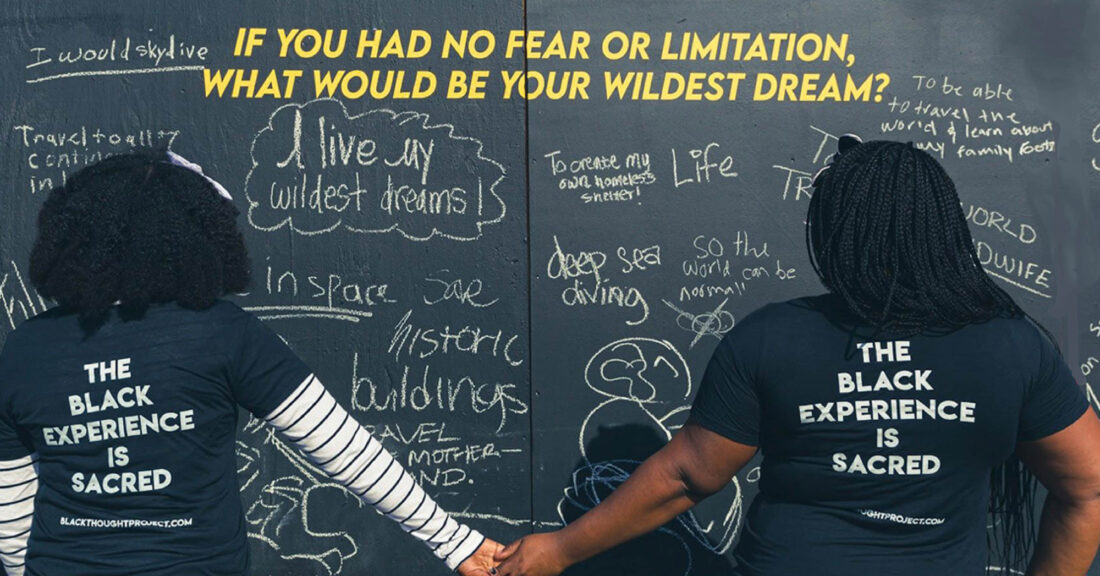Learning From Black Communities Through Art

A new report spotlights a series of interactive community-based art installations that provide a space for Black people to reflect on their experiences. Called the Black Thought Project: Lessons on Centering Blackness, the report explores how these large public art walls have engaged people of all races in an effort to transform society’s negative beliefs about Black people into affirmations of their humanity, wisdom and possibilities.
Conceived of by Maven Collaborative Fellow Alicia M. Walters, the Black Thought Project has built 15 walls — as large as eight feet high and 48 feet long — in partnership with organizations and creators in communities including East Oakland, California, and Harlem, New York City.
“I wanted people to feel what it is like to be in right-relationship to Blackness,” Walters writes in her introduction to the report. “For Black people to reflect on our own lives and perspectives knowing we are being protected, not threatened or considered a threat; witnessed, not profiled, judged or surveilled; our expressions honored, not commodified or exploited. For us to be in our joy and our healing in public without shame or fear.”
“This project offers an innovative approach to partnering with community members by providing safe spaces to express their thoughts and perspectives,” says Kimberly Spring, director of Research and Evaluation at the Annie E. Casey Foundation, a cofunder of the Black Thought Project.
Making Spaces for Black Thought
The Black Thought Project report details the process for creating a wall. It begins by engaging Black community members in conversation to confirm that the project will be welcomed by residents. When considering the location of a wall, project leaders ask themselves:
- What is the Black community’s relationship to this place?
- Did anything happen here that may prevent Black people from feeling safe?
- Does law enforcement have an active presence here that may intimidate or threaten the safety of Black people?
Each Black Thought wall requests the Black community’s written responses to topics such as:
- individual worth and dignity;
- aspirations for the community; and
- healing and repairing harm.
Although only Black people are allowed to write on the wall, non-Black community members — called “thought protectors” — are trained to protect the wall as a space for Black expression. When non-Black people attempt to write on the wall, thought protectors intervene and engage them in conversation about the project’s purpose.
The public display of responses shows the power of Black self-determination. It gives people who are not Black exposure to authentic Black expression. This kind of engagement counters narratives that lead to the devaluation and dehumanization of Black people, shifting focus to what Walters calls “the beauty, vibrancy and resilience in being Black and the endless, irresistible possibilities when we are free to be and to dream.”
To date, the project has averaged 1,000 responses per wall.
Lessons from the Black Thought Project
Among the Black Thought Project’s lessons, the report highlights:
- Build trust. Combat a community’s initial skepticism about participating in the project by building trust in the wall’s creators as facilitators.
- Plan ahead. Ensure venues have agreed in advance about details such as how long the wall will remain standing and how to keep it clean.
- Continue the conversation. The wall’s responses are just the beginning; there must be ongoing, in-depth conversations about what people wrote.
“The Black Thought Project focuses on what is already beautiful and going well, including the clarity, creativity, talent and wisdom that’s already present within the community,” says Oronde Miller, director of Equity and Inclusion at the Casey Foundation. “Ideally, all of this would come together to form the building blocks for responding to any number of community challenges, including community healing and repair and the transformation of any systems and institutions that contribute to those challenges.”
Building Out the Black Thought Project
Walters and the Maven Collaborative hope to expand the Black Thought Project into more communities and create permanent spaces. They envision co-creating walls focused on specific Black experiences that are often overlooked, like those of women, immigrants and the LGBTQ community. In any setting, the project might look different based on what that community’s members decide they want it to be.
“Wherever Black people are misunderstood, displaced, systemically harmed, there the Black Thought Project shall be,” the report states. “Wherever there are Black people with untapped wisdom, unexpressed dreams, unheard solutions, there should be Black Thought Walls inviting and protecting their expressions.”
“The project makes it clear that the community isn’t lacking vision and aspiration,” says Miller. “Communities are almost always prepared to tell you what they want and what they need, but they have too often not been provided the resources, investment and other supports to realize that vision.”
Subscribe to the Foundation’s equity and inclusion newsletter






